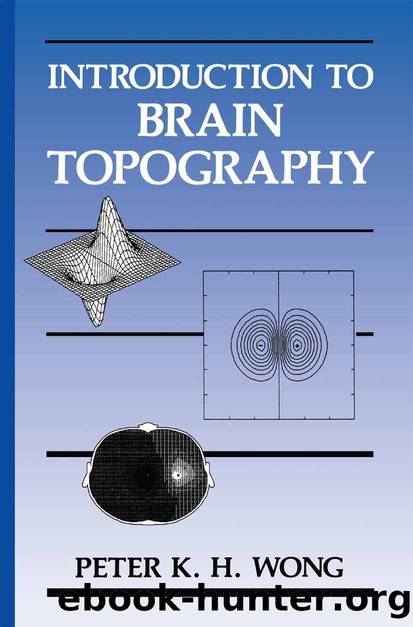Introduction to Brain Topography by Peter K. H. Wong

Author:Peter K. H. Wong
Language: eng
Format: epub
Publisher: Springer-Verlag Wien 2012
Published: 2015-01-23T00:00:00+00:00
Part 4
Statistical Approaches
Peter K. H. Wong1
(1)University of British Columbia and British Columbia Childrenâs Hospital, Vancouver, British Columbia, Canada
4.1 INTRODUCTION
As for any other bio-medical measurement, topographic maps are subject to variations, not only among subjects, but even at different times within the same subject. Therefore statistical methods must be employed in order to separate the consistent part of the features of interest from the variability due to extraneous factors. For instance, in order to study and understand the significance of a spike topography, one must be able to identify the salient characteristics of that structure and separate them from minor and irrelevant variations in space, time and magnitude (alpha, muscle artifacts etc.).
A distinguishing feature of brain topography with respect to statistical analyses is its need for âmultivariateâ procedures. While in most scientific research variables are analyzed one at a time, the nature of brain topography requires that several variables be measured simultaneously. Multichannel readings and measures repeated in time introduce features of correlation, both temporal and spatial, that must be considered in a statistical analysis. Univariate analysis does find its place here as well, since some features obtainable through a map deserve separate study. Moreover many terms and problems of univariate statistics extend to the multivariate case. For instance one has the basic problems of distinguishing between continuous variables (usually coming from measurements) and discrete variables (usually counts); or between ordinal variables (when the values have a natural order) and nominal variables (when the values have no meaningful order); or between estimation (assessing the magnitude of a variable) and testing (verifying a certain statement about variables); and one runs into sample size problems etc.
While statistical methods have become popular in EEG and their use widespread, caution must be exercised when using them, since practically all such methods make a number of theoretical assumptions that must be met. All address certain very specific questions that may not be the most appropriate for the problem at hand. These aspects will be discussed in the next chapter.
Statistical methods of interest in brain topography address one of the following three basic problems: a)Estimation: Identifying the average topography associated with a certain state and its degree of variability. Two types of problems fall into this category: 1) determining the average map characteristic of a state in a given subject; 2) search for ânormative dataâ characteristic of a group of subjects sharing the same condition, including ânormalityâ. These problems are discussed in Chapter 4.3. An example could be the estimation of the average peak topography for a rolandic spike in a given patient and in all patients with benign rolandic epilepsy (Wong et al. 1989).
Download
This site does not store any files on its server. We only index and link to content provided by other sites. Please contact the content providers to delete copyright contents if any and email us, we'll remove relevant links or contents immediately.
| Administration & Medicine Economics | Allied Health Professions |
| Basic Sciences | Dentistry |
| History | Medical Informatics |
| Medicine | Nursing |
| Pharmacology | Psychology |
| Research | Veterinary Medicine |
Periodization Training for Sports by Tudor Bompa(7929)
Why We Sleep: Unlocking the Power of Sleep and Dreams by Matthew Walker(6364)
Paper Towns by Green John(4807)
The Immortal Life of Henrietta Lacks by Rebecca Skloot(4264)
The Sports Rules Book by Human Kinetics(4081)
Dynamic Alignment Through Imagery by Eric Franklin(3925)
ACSM's Complete Guide to Fitness & Health by ACSM(3827)
Kaplan MCAT Organic Chemistry Review: Created for MCAT 2015 (Kaplan Test Prep) by Kaplan(3805)
Introduction to Kinesiology by Shirl J. Hoffman(3629)
Livewired by David Eagleman(3535)
The River of Consciousness by Oliver Sacks(3421)
The Death of the Heart by Elizabeth Bowen(3342)
Alchemy and Alchemists by C. J. S. Thompson(3299)
Descartes' Error by Antonio Damasio(3168)
Bad Pharma by Ben Goldacre(3106)
The Emperor of All Maladies: A Biography of Cancer by Siddhartha Mukherjee(2934)
The Gene: An Intimate History by Siddhartha Mukherjee(2929)
The Fate of Rome: Climate, Disease, and the End of an Empire (The Princeton History of the Ancient World) by Kyle Harper(2878)
Kaplan MCAT Behavioral Sciences Review: Created for MCAT 2015 (Kaplan Test Prep) by Kaplan(2823)
